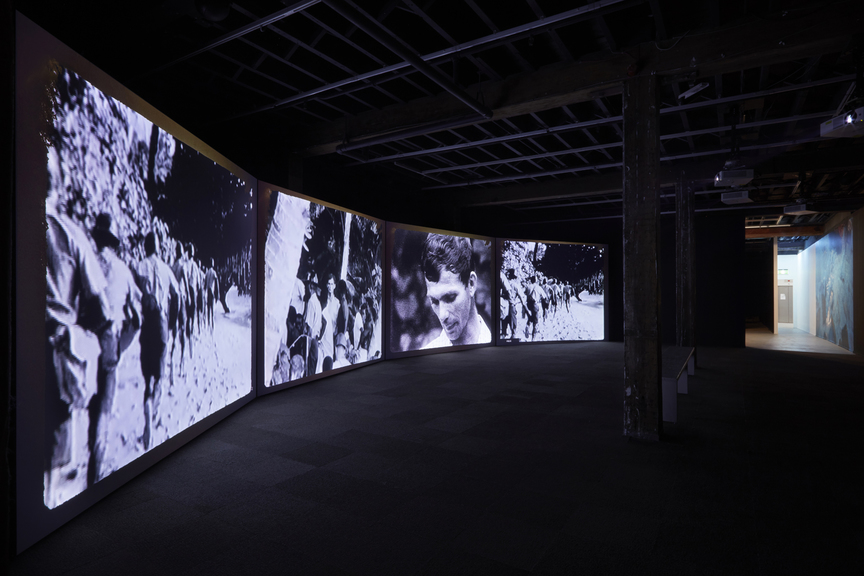-
From Current Issue
-
- Editor’s Letter Fire in the Heart
- Reviews I Gusti Ayu Kadek Murniasih
- Reviews 11th Seoul Mediacity Biennale: “One Escape at a Time”
- Dispatch Networked China
- One on One Monira Al Qadiri on Yukio Mishima
- Essays The rise of independent art spaces in pandemic-era Shanghai
- Features Tuan Andrew Nguyen
- Table of Contents
- Web Exclusives
- Archive
- Subscribe

R
E
V N
E
X
T
Installation view of TALOI HAVINI’s Habitat, 2018–19, four-channel video: 10 min 35 sec, at “Reclamation,” Artspace, Sydney, 2019–20. All photos by Zan Wimberley. All images courtesy the artist.
A glossy photograph of blue rocks transformed the entrance of Artspace into an alluring aquamarine archway. However, this beguiling wallpaper contradicted the dark histories explored inside the gallery. In reality the image depicts copper patina, a metonym for copper mining in the Autonomous Region of Bougainville in Papua New Guinea. In her first Australian solo exhibition, “Reclamation,” the Bougainville-born, Sydney-based artist Taloi Havini interrogated the industry’s detrimental legacy.
By aestheticizing the mineral Havini alludes to the colonial mindset, wherein resources are objectified and rendered desirable while its deeper histories and resonances for the First Nations communities who traditionally owned the land are erased. The gallery’s deceptive facade thus cleverly implicates visitors in Australia’s collective ignorance of ongoing resource imperialism in the Pacific.
In her four-channel video installation Habitat (2018–19), Havini focuses on the Panguna mine, which was controlled by a subsidiary of the Australian company Conzinc Rio Tinto from 1972 to 1989, and was at the time the world’s largest open-pit copper and gold mine. Archival footage from local protests reveals that the mine represents the theft of land and culture from Bougainville First Nations communities. There are some poignant moments in the short film, including a transcribed quote from Bougainville leader Raphael Bele who wrote in 1969 that “to Bougainvilleans, land is like the skin on the back of your hand . . . you would not expect us to sell our skin, would you?” Intimate close-up shots of wrinkles in skin are interspersed with aerial shots of the land, collapsing the macro with the atomic, the earthly with the corporeal. The work refuses to shy away from the damage inflicted by colonial-capitalist greed, an oft-omitted part of White Australian history.
The strength of “Reclamation” did not lie only in its unapologetic and emphatic confrontation, but also in the ways that Havini gracefully privileged Indigenous epistemologies. Her site-specific installation Reclamation (2019) consists of a sand-filled room featuring seven cane and vine structures—created with Havini’s Hakö clan members—that resemble archways decorated with traditional patterns. Spotlights dramatically accentuate these structures, casting shadows on the undulating sand beneath. Through this shadow play, Reclamation puts emphasis not on the objects, but on the indigenous knowledge embodied by and embedded within them, evoking intangible cultural heritage, and conceptualizing a time and space away from prevailing Western paradigms. Havini’s works coalesce into an ecosystem that transformed the gallery into a site of hope, resistance, and emancipation.
Taloi Havini’s “Reclamation” is on view at Artspace, Sydney until February 23, 2020.
To read more of ArtAsiaPacific’s articles, visit our Digital Library.

















